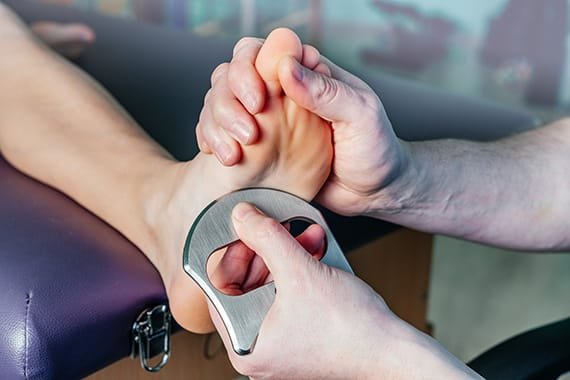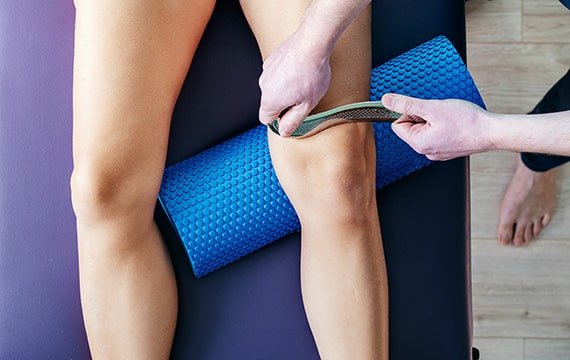Instrument Assisted Soft Tissue Mobilization (IASTM)
Clinicians use various instruments with different shapes and sizes to achieve deeper mobilization of tissue in various parts of the body.
What is IASTM?
Instrument Assisted Soft Tissue Mobilization (IASTM) is a technique widely used by physiotherapists and chiropractors to enhance their manual therapy interventions. By utilizing specialized stainless steel instruments with beveled edges and contours, clinicians are able to achieve deeper mobilization of soft tissues in various parts of the body.
These instruments are designed to conform to different anatomical locations, allowing for precise and targeted treatment. The beveled edges enable clinicians to apply controlled pressure to specific areas, facilitating the identification and treatment of scar tissue, fascial restrictions, and adhesions. The contours of the instruments provide the ability to adapt to the body’s curves and contours, enhancing the technique’s effectiveness.
With IASTM, clinicians can achieve deeper penetration into the tissues, which may not be possible with manual techniques alone. This technique promotes tissue mobility, increases blood flow, and stimulates the body’s natural healing process. Additionally, IASTM can help improve the range of motion, reduce pain, and enhance overall function. It is important to note that IASTM should only be performed by trained professionals who possess the necessary knowledge and skills to ensure patient safety and provide appropriate treatment.
At Physio Pros, the use of IASTM instruments with beveled edges and contours allows their clinicians to deliver targeted and effective soft tissue mobilization. These specialized stainless steel instruments enable precise treatment by conforming to different anatomical locations, ensuring optimal contact and penetration into the affected tissues.
How does it work?
Instruments effectively break down deeper layers of fascial restrictions and scar tissue in and around muscles, joints and ligaments. The ergonomic design of these instruments provides the clinician with the ability to locate restrictions and allows them to treat the affected area with a desired amount of pressure. The introduction of controlled micro trauma to affected body regions causes the stimulation of a local inflammatory response. Micro trauma initiates reabsorption of inappropriate fibrosis or excessive scar tissue and facilitates healing processes resulting in remodeling of affected soft tissue structures.

What conditions can IASTM be used for?
- Tennis Elbow/Golfers Elbow
- Carpal Tunnel Syndrome
- Neck Stiffness/Pain
- Plantar Fascitis
- Rotator Cuff Tendinitis
- Patellar Tendinitis
- Tibialis Posterior Tendinitis
- Heel Pain /Achilles Tendinitis
- Post-Surgical and Traumatic Scars
- Myofascial Pain and Restrictions
- Post-Surgical and Traumatic Scars
- Myofascial Pain and Restrictions
- Chronic Joint Pain
- Ligament Sprains
- Muscle Strains
- Back Pain
- IT Band Syndrome
- Shin Splints
- Scars (Surgical, Traumatic)
Benefits of IASTM
Massaging muscle, joint and ligament tissue on a deeper level has been shown to increase inflammatory response, increase collagen fiber production and promote healing. In doing so, athletes, chronic pain patients, acutely injured individuals can return to do the things the love, faster.
Other benefits of IASTM include:
- Modulating pain
- Restoring proper muscular function
- Speeding up recovery time
- Reducing inflammation
- Improved mobility and range of motion
- Alleviating chronic pain conditions
- Improved tissue remodeling

What to expect from the IASTM treatment
A clinician will thoroughly describe the risks and benefits of IASTM treatment. During treatment controlled micro trauma will essentially re-create an inflammatory response in the body to promote healing and recovery. During the treatment, patients may have some discomfort, and may have some soreness in the area that was treated for several days after. There may also be some discoloration on the surface of the skin when treatment is completed.
In many instances a combination of various treatment(s) may provide the best outcomes, which may include: Massage Therapy, Chiropractic Care, Dry Needling/Acupuncture, Custom Bracing for affected joints, Cupping or Kinesiotaping.

